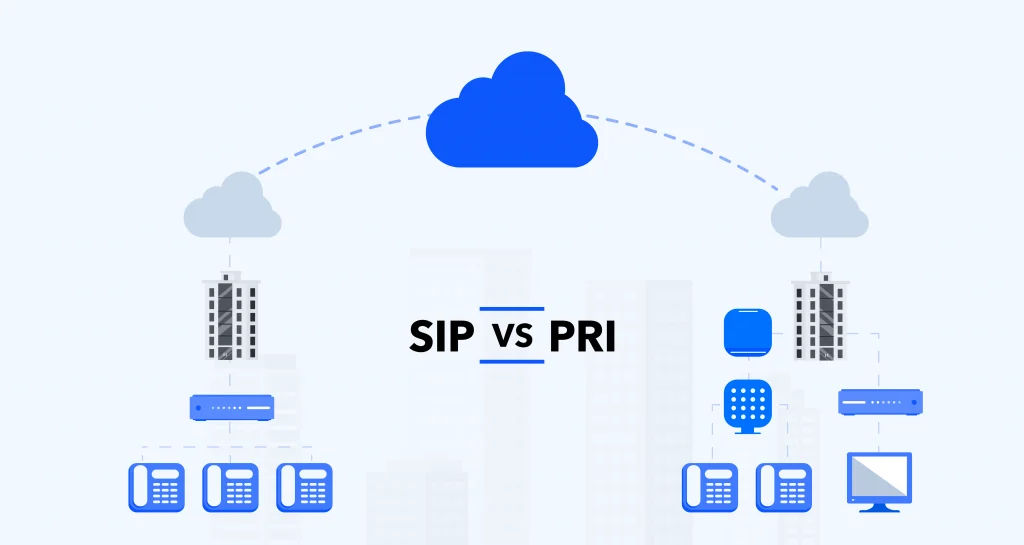SIP Trunk and PRI is a telecommunications technology designed to expand the capabilities and connectivity of your business phone system. PRI was known years ago as the gold standard for synchronous, high-speed communication. But nowadays it is not as popular as it used to be. Today’s companies also have a fully virtual, highly scalable business phone system. At the point of communication solution, you are also more likely to use a SIP Trunk. In this article, you will see the SIP Trunk vs PRI differences in outline. You’ll explain to yourself how each of them works. We will also talk about its advantages and disadvantages.
What Distinguishes SIP Trunking and PRI?
Many people wonder about the distinctions between PRI and SIP. We’ll show you the differences by outlining both. SIP Trunk is the group of interconnected phone lines that make up your business’s virtual telephone network. It’s quite similar to an analog phone line. Each SIP Trunk is assigned to a person, department, or other user group. The difference between SIP Trunk from PRI is that it makes it easier to add, update, and remove additional phone lines. Because all this does not require additional hardware. It even comes with a lengthy installation process.
At the same time, SIP Trunk not only manages VoIP voice calling. It enables real-time and multi-channel unified communications via voice, video, messaging, virtual fax, and more. From a technical point of view, SIP Trunk allows an unlimited number of audio channels and an unlimited number of simultaneous calls. Many businesses purchase a certain number of SIP Trunks for a more cost-effective option.
PRI is known as the Primary Speed Interface. It can physically connect to your PBX within T-carrier systems and on-premises. PRI is a telecommunications technology that provides access to 23 simultaneous voice and data channels per line. PRI was developed as an alternative to the traditional POTS network, which only provides 1 phone call at a time. POTS facilitates analog calls only via the PSTN. In short, it is impossible to access virtual communication channels such as video calling, online fax, and messaging. It’s also important for businesses to make and receive phone calls simultaneously. PSTN is needed to transmit digital data.
You can enter T-carrier systems that use pulse modulation and time-division multiplexing to enable the transmission of digital data via the PSTN. ISDN was developed to make it easier to travel audio, video, text, and media data over the PSTN at the same time. PRI is also a type of ISDN developed specifically for businesses that need access to concurrent lines. PRI also assigns separate extensions for each user. It introduced DID, which facilitates internal communication and allows customers to instantly connect with the person they want to reach.
What is SIP and How Does It Work?

SIP stands for Session Initiation Protocol. Establishes two-way communication links between endpoints. This allows you to resume and end communication. It is a signaling protocol that also facilitates Internet-based VoIP communication systems. SIP sessions refer to VoIP communications that usually take place over the internet. VoIP is often referred to as IP telephony. But it doesn’t stop there. It covers all forms of virtual communication, not voice searching. In addition to voice-based communication, VoIP technology offers its users many possibilities such as video conferencing, SMS and MMS messaging, virtual fax, instant chat messaging, etc.
Because VoIP communication is virtual, it is not pinned to a single physical location. SIP endpoints aren’t just limited to traditional wired landline phones. The SIP Protocol also enables versatile multimedia communication between users via any device, including desktop computers, smartphones, tablets, laptops, text phones, and an internet connection. While services depend on your internet connection and quality, providers offer telephone network reliability through redundancy, failover plans, and redundant power supplies. In addition, SIP Trunk provides businesses with free, unlimited local and long-distance calling access. Making SIP calls over the internet brings with it many advantages.
SIP works by providing VoIP connectivity to your existing PBX system to send and receive business communications over the Internet, rather than the physical lines and physical circuits of the PSTN. In addition to the mobility of cloud communications, SIP data connectivity gives legacy phone systems and landline users easy access to the advanced functionality and scalability of VoIP. So how does this happen?
The SIP signaling protocol collects a few pieces of information to successfully facilitate a virtual session between two endpoints. Most of the data collected are located at the user’s IP address. It has the user’s location, usability, and most importantly, compatible codecs. It greatly simplifies two-way IP communication through data transfer and packet switching. All this is done with codecs. Packet switching distributes analog data across the IP network into many small data packets between endpoints. At the same time, keep in mind that SIP is just one of the protocols that facilitate VoIP. Apart from:
- SDP (Session Description Protocol)
- RTP (Real-Time Transmission Protocol)
- TCP (Transmission Control Protocol)
- UDP (User Datagram Protocol)
Which Is Better, a SIP Trunk or a PRI?
If you want to learn which technology is more suitable for your needs among SIP Trunk vs PRI phone systems, you can learn the answer in this article. Knowing the difference between SIP vs PRI will help you decide when choosing the best communication technology for your business. In this article, we will examine the advantages and disadvantages of both technologies and guide you to make the right choice for you. So you can decide which technology is better for your company.
What Is the Primary Difference Between SIP Trunks And PRI?

Session Initiation Protocol (SIP) is a system that emerged with the rise of the Voice over Internet Protocol (VoIP). You can also use virtual connections to manage both voice and data transmissions. At the same time, the Primary Speed Interface (PRI) uses custom lines or physical T1 transmission technology to enable sound transmission over copper lines in buildings. A similarity between PIR vs SIP is that both connect businesses to the Public Switched Telephone Network. Both technologies have three main categories of differences. These:
- Connectivity: SIP Trunk uses a virtual connection over a network. PRI, on the other hand, uses a physical connection through a PRI circuit.
- Forwarding: SIP outline calls provide transmission using data packets that reside on a virtual network. PRI calls are transmitted through physical circuits.
- Scalability: SIP Trunk is limited only by your bandwidth. PRI is limited to the number of wired telephone lines.
Both PRI SIP technologies are competitive in the industry. Therefore, both technologies have distinct advantages and disadvantages in themselves.
Advantages: SIP Trunk
1-Cost and Reliability
SIP Trunk is a cost-effective use. Traditional phone service charges you differently for local and international calls. In addition, SIP Trunk is billed on a per-user basis. Therefore, it is much cheaper. This billing helps you estimate your monthly bill. A business using SIP Trunk can expect cost reductions of 30% and 40%.
If IP phones are unable to complete calls as a result of being disconnected from the internet, SIP Trunk makes failover to mobile phones quite easy and fast. It uses VoIP applications that SIP employees can install on their mobile devices. In this way, employees will always be connected to the communication systems of your organization. It helps your employees and customers stay in touch, even without a data connection.
2-Manageability and Scalability
SIP Trunk is very easy to manage and use. If you want to protect your phone numbers while growing your business, SIP Trunk lines are very useful. You can easily add phone lines when you need them. You can also remove it at any time. SIP Trunk helps your organization grow across multiple geographic locations. It also combines voice and data into a single connection. This helps your organization connect with remote workers. You can also take your SIP Trunk phone lines with you when you relocate.
With SIP Trunk, it is possible to expand your communication network without physical infrastructure. Traditional telephonic services help establish new telephone lines. SIP only requires you to connect your devices and your connection as well. It does not require special telephone lines like traditional telephone service. So it helps you expand.
3-Cloud-Based and Mobility
If SIP Trunk is part of the Unified Communications application (UC), its configuration takes place through the cloud. Because it’s in the cloud, SIP bodies have excellent mobile capability.
4-Integrations and Flexibility
SIP Trunk has a lot of integrations that increase collaboration and productivity. An example of this is the integration provided to multimedia communication. You can also combine PRI with a hybrid or even SIP Trunk, allowing you to get the most out of both technologies.
With SIP Trunk, you can move your office but keep your current phone number by providing phone number flexibility. This feature helps you keep your current phone number while reducing the number of PBXs you need to protect.
Disadvantages: SIP Trunk
SIP Trunk has advantages as well as disadvantages. These:
- SIP Trunk needs fast bandwidth to make quality voice calls.
- Because of the internet connections, you should make sure that you have installed firewalls and other security protocols to prevent cyber-related crimes.
- You must have a phone system that is compatible with this technology.
Advantages: PRI

1-Regardless of Bandwidth
The biggest advantage of PRI is that voice calls don’t depend on bandwidth and data connections. You can also do well with a connection that uses physical lines. It also means that the sound quality is not bandwidth sensitive since it is also shared. If your business doesn’t have access to high-speed data connections, PRI will also be a reliable use for your voice communications. With PRI, you can have a high-quality telecommunications system, especially for businesses where there are no high-speed data connections.
2-Great Quality of Calling
PRI calls can be set up easily. It has a voice quality far superior to Public Switched Telephone Network (PSTN) channels. Higher sound quality is also due to the end-to-end digital PRI connection and dedicated physical lines.
3-Compatible and Secure
PRI demonstrates working with some IP-based phones to support much older technologies, such as fax machines. You can use PRI connections with multiple communication features, such as data transfer and fax transmission. With these features, you can use them at the same time without any change in quality.
Are PRI lines safe? PRI lines are very reliable and safe lines. When PRI data is transmitted over physical lines, it is not possible to hack PRI lines when the internet is not used. It can’t even be easily rested. It is also quite easy to troubleshoot in case of technical failure.
4-Certain Call Features
PRI lines are known for their feature called Direct Internal Dialing (DID). This feature allows businesses to publish different phone extensions for their departments. It also makes it easier for customers and stakeholders to communicate directly with departments. When these departments call customers, customers receive the extension number in their caller ID. The number is then used to reach that department directly without going through customer support.
PRI lines also feature ACD, which automatically sends calls to the next free line when the called line is busy. It answers customers’ calls and your organization starts getting a lot more business.
5-Failover Features
If a second PRI circuit is added for failover, you get a redundant system with improved reliability.
Disadvantages: PRI
PRI is a technology that has pros as well as cons. These:
- The installation and upgrade of the PRI system are also quite expensive. That’s why monthly phone service plans exceed IP-based phone services, especially for long-distance calls.
- Phone companies that sell PRI generally need long-term contracts for local and long-distance calls.
- It slows downscaling because it is dependent on the physical infrastructure.
- PRI security risks include search interference.
- PRI does not have mobile failover in the event of failures and emergencies.
- With the greater adoption of SIP, there is a shortage of expert PRI technicians.
For whom is SIP ideal?

SIP is the best choice for businesses that want to keep up with their competitors, provide a better service against growing consumer needs, and immediately scale their communication capabilities to improve their overall workflow through access to advanced features and third-party integrations.
SIP Trunk makes your business phone system fully mobile. This makes it a great option for remote and hybrid teams that work in multiple time zones and are constantly on the move. SIP continues to provide access to additional communication channels and advanced features. It’s highly affordable and an ideal choice for businesses looking for a scalable business phone system.
Many VoIP equipment is optional. It helps you save on both initial costs and office space requirements. Businesses also allow you to add many more custom lines and features as needed, not in bulk. In this sense, you can choose the plans that stand out gradually and as you use them.
At the same time, you can always keep your communication alive with unlimited long-distance and local calls. Thanks to SIP Trunk, national calls are much more affordable. Best of all, end users aren’t responsible for maintenance fees or internal IT teams.
For whom is PRI ideal?
PRI is a great choice for office businesses that need access to additional communication channels other than voice communication and need the ability to make lower volume concurrent calls, only during peak times of the year.
PRI users want to host their business phone systems in-house. In this sense, they also have the in-house equipment in which they probably invest the most important. That’s why they want to keep using it. If your telephone network is not virtual and copper lines are used to create a physical connection, PRI offers a consistent and reliable, high-quality service without being affected by internet connectivity.
Is SIP superior to PRI?
While SIP is much more cost-effective, if not better, than using PRI. You can also manage on-premises and in the cloud. Unlimited concurrent calls offer unlimited SIP Trunks. It helps users access their work phone systems from anywhere. You may also consider that the process of dropping PRI with the PSTN is getting very much underway.
Is PRI equivalent to VoIP?
PRI is not the same as VoIP. This is because PRI requires a physical connection to the PSTN through on-premises circuits and copper cables. But VoIP is a completely virtual structure. Simplifies communication with the IP network.
A PRI contains how many lines?
There are 23 concurrent lines available within the PRI system. Technically, however, each of these 23 communication channels can be assigned 50 phone numbers. You also can’t use more than 23 at the same time.
SIP vs PRI Comparison Summary
In this article, we have tried to explain the differences between SIP Trunk vs PRI more clearly. In summary, SIP Trunk uses a virtual connection to perform both voice and data communication. PRI, on the other hand, uses special copper lines to provide sound transmission in buildings. It should be remembered that both technologies have their advantages and disadvantages. With SIP networks, you can achieve easy management, lower costs, and greater flexibility. It is possible to make safer voice calls without the need for an internet connection for PRI.

13 responses